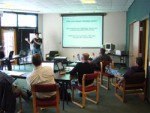Network-based research in LTER involves a diverse array of activities requiring multiple solutions for supporting its information needs. One of the goals of the LTER Network is to have a simplified way to access and synthesize data at the individual research sites, as well as across the entire LTER Network. To provide for this, a system known as the LTER Network Information System (NIS) will support LTER site scientific research as well as networklevel datasets such as information on site characteristics, climate, hydrology and cross-site datasets produced for LTER science themes and workshops. The LTER NIS will contain generic solutions or tools that will make discovery, access, aggregation, and visualization of data across multiple sites easier and more efficient. To provide a vision and to guide the development of the NIS, the LTER Network Information System Advisory Committee (NISAC) was approved as a standing committee. The NISAC is chaired by Andrews LTER information manager Don Henshaw, and includes five LTER site principal investigators: Mark Harmon, Tim Kratz, Stuart Gage, Debra Peters, and Robin Ross, four LTER information managers: Peter McCartney, Barbara Benson, Emery Boose, and Don Henshaw, and four members of the LTER Network Office: James Brunt, Bill Michener, John Vande Castle, and Bob Waide.
The NIS Advisory Group provides a necessary forum for discussion and planning among the three crucial sets of participants—the LTER science community, LTER Information Managers, and the LTER Network Office—in designing and implementing an information infrastructure to support network synthetic science.
As part of a strategic plan, the NIS Advisory Group will make recommendations on goals and timeframes for NIS development and will prepare an assessment report for presentation to the LTER Coordinating Committee.
The NISAC first met at the Kellogg Biological Station in May of 2003 to begin the task of defining what the LTER Network Information System (LTERNIS) will be and a strategic plan for its implementation. The NISAC produced a report outlining their initial discussions and also presented their ideas to the LTER Executive Committee and full LTER Coordinating Committee in May of 2003.
The NISAC feels that the LTER NIS will need collaborations and partnerships with information specialists beyond the LTER Network, and will LTER Network Information System Advisory Committee explore potential partnerships by holding its upcoming meetings at the National Center for Supercomputing Applications (NCSA) and San Diego Supercomputer Center (SDSC), as well as at the NCSA in Champagne, IL.
The NISAC will review development of the LTERNIS including networklevel databases, site participation within a tiered LTERNIS functionality framework, as well as the synthesis products themselves. They will also meet with researchers at NCSA to discuss potential projects, collaborations, and partnerships.
The NISAC will meet again in early June 2004 with researchers at SDSC. Further information regarding the LTER NISAC can be found on their committee web page at: http://intranet2.lternet.edu/content/nisac

 Enlarge this image
Enlarge this image